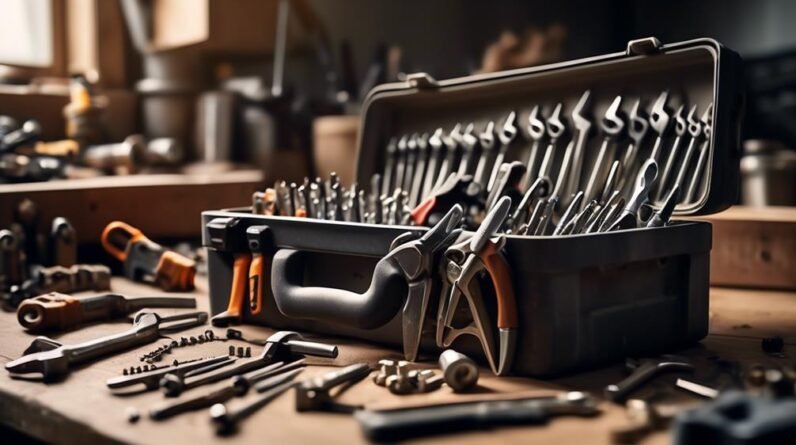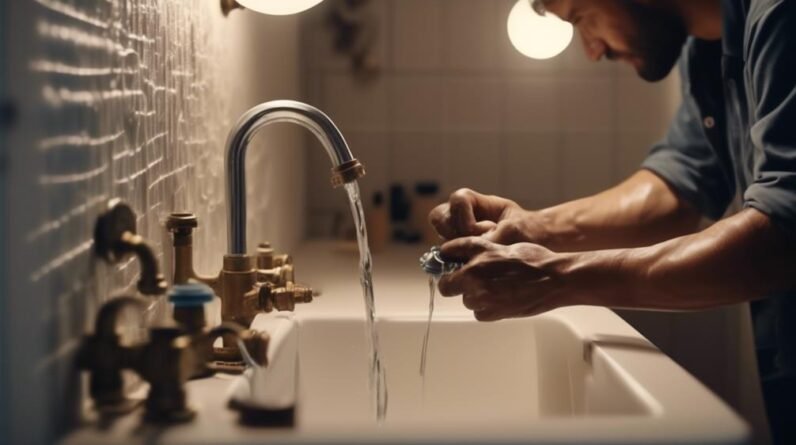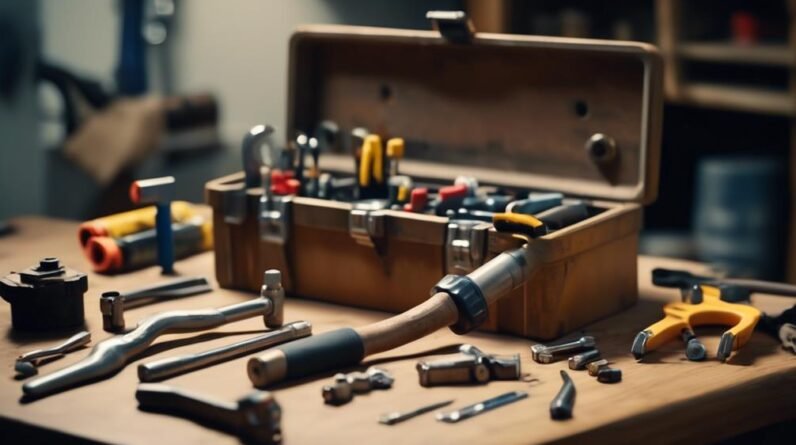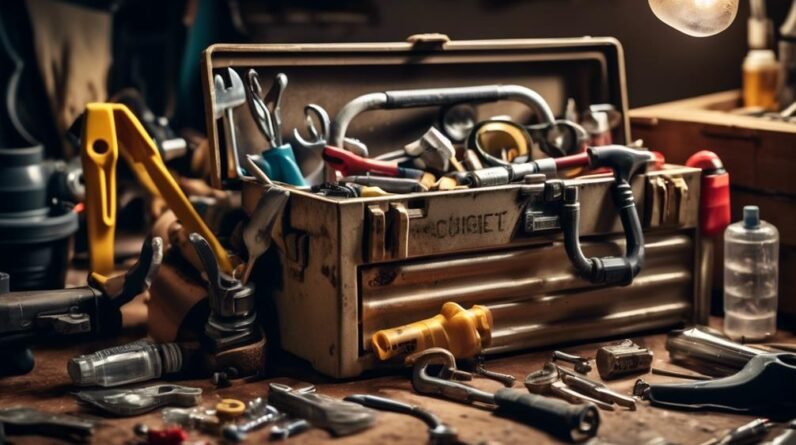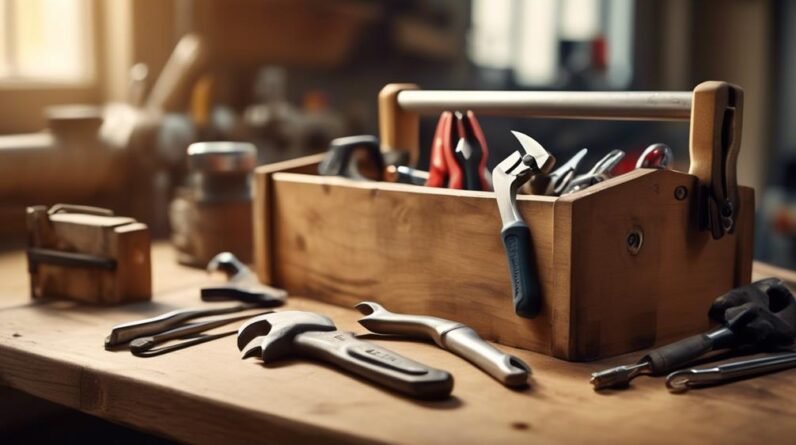
So, you've found yourself face-to-face with yet another leaky faucet, a clogged drain that refuses to cooperate, or a squeaky door that wakes up the whole neighborhood every time you open it. Don't worry, we've all been there. But fear not, for there are efficient DIY fixes for these common household problems that can save you time, money, and the hassle of waiting for a professional to come to the rescue. From flickering lights to broken tiles, we've got you covered. So, why not discover these simple yet effective solutions that will have you feeling like a DIY pro in no time?
Key Takeaways
- Regular maintenance and inspection of faucets can help prevent leaks and ensure proper water pressure.
- Various methods, such as boiling water, baking soda and vinegar, plunging, and manual removal, can be used to unclog drains.
- Squeaky doors can be fixed by identifying the squeaky hinges and applying lubricant accordingly.
- Flickering lights can be resolved by checking for dimming bulbs, inspecting switches for loose connections, and tightening any loose connections at the light fixture, switch, and electrical panel.
Leaky Faucets
If you have a leaky faucet, there are a few simple steps you can take to fix it yourself and save money on plumbing services. The first thing to check is the water pressure. Sometimes, high water pressure can cause faucets to leak. You can adjust the water pressure at the main shut-off valve using a wrench. Turn the valve clockwise to decrease the pressure and counter-clockwise to increase it.
Next, gather the necessary plumbing materials. You will need an adjustable wrench, a screwdriver, and replacement parts such as washers or O-rings. These can be found at your local hardware store.
To fix the leaky faucet, start by turning off the water supply to the faucet. This can usually be done by turning the valve under the sink. Next, use the adjustable wrench to remove the handle of the faucet. Once the handle is removed, use the screwdriver to unscrew the valve stem.
Inspect the washer or O-ring for any signs of wear or damage. If necessary, replace them with new ones. Reassemble the faucet and turn on the water supply. Check for any leaks and make sure the faucet is functioning properly.
Clogged Drains
Now let's tackle another common household problem: clogged drains. Dealing with slow drainage or a foul odor from clogged drains can be frustrating, but luckily, there are a few DIY fixes you can try before calling a plumber. Here are three effective methods:
- Boiling Water: This is the simplest and most common solution for minor clogs. Boil a pot of water and carefully pour it down the drain in a slow, steady stream. The hot water can help break down and flush away any grease or debris causing the clog.
- Baking Soda and Vinegar: Create a natural cleaning solution by mixing equal parts baking soda and vinegar. Pour the mixture down the drain and let it sit for about 30 minutes. Then, flush it with hot water. The chemical reaction between the baking soda and vinegar can help dissolve the clog and eliminate any unpleasant odors.
- Plunger: A plunger can be an effective tool for unclogging drains. Ensure there is enough water in the sink or tub to cover the rubber part of the plunger. Place the plunger over the drain and push down firmly, then pull up quickly. Repeat this motion several times to create suction and dislodge the clog.
Squeaky Doors
To silence those annoying squeaky doors, all you need is a little lubrication and a few simple tools. Door hinges often squeak due to friction between the metal parts. By applying lubricant to the hinges, you can eliminate the noise and ensure smooth door movement. Here's a simple step-by-step guide on how to fix squeaky doors:
- Gather your tools: Before starting, make sure you have the following tools ready:
- Lubricant spray or oil
- Rag or cloth
- Screwdriver
- Identify the squeaky hinges: Open and close the door slowly to locate the squeaky hinges.
- Apply lubricant: Use the table below as a guide to applying the lubricant properly.
| Hinge Type | Lubricant Application |
|---|---|
| Standard hinge | Spray lubricant on the top and bottom of the hinge pins. |
| Piano hinge | Apply lubricant along the entire length of the hinge. |
| Butt hinge | Remove the pin, apply lubricant, and reinsert the pin. |
- Wipe off excess lubricant: After applying the lubricant, use a rag or cloth to remove any excess.
- Test the door: Open and close the door a few times to check if the squeaking has stopped. If necessary, reapply the lubricant and repeat the process.
Flickering Lights
Flickering lights can be a frustrating problem to deal with, but with a few simple steps, you can quickly resolve the issue. Here's what you need to do:
- Check for dimming bulbs: Sometimes, flickering lights can be caused by dimming bulbs. If you have dimmer switches installed, make sure you are using bulbs that are compatible with them. Using the wrong type of bulbs can cause flickering. Replace any dimming bulbs that are not compatible with your dimmer switches.
- Inspect faulty switches: Faulty switches can also be a common cause of flickering lights. Inspect the switches to see if they are loose or damaged. If you notice any issues, such as loose connections or burnt wires, it's best to replace the switch. Remember to turn off the power before attempting any repairs.
- Check for loose connections: Loose connections in the electrical wiring can cause lights to flicker. Turn off the power and inspect the connections at the light fixture, the switch, and the electrical panel. Tighten any loose wires and ensure all connections are secure.
Broken Tiles
Are you dealing with broken tiles in your home? Don't worry, fixing them is easier than you think. Whether it's a cracked tile or a loose one, you have a couple of options for repairing the damage: grout repair or tile replacement.
If the tile is still intact but the grout around it is crumbling or discolored, you can start by focusing on grout repair. First, remove the old grout using a grout saw or a utility knife. Be careful not to damage the surrounding tiles. Once the old grout is removed, clean the area thoroughly and let it dry. Then, apply new grout using a grout float, making sure to fill in all the gaps. Wipe away any excess grout with a damp sponge and let it cure for at least 24 hours.
If the tile itself is cracked or broken, you will need to replace it. Start by removing the broken tile using a chisel and a hammer. Be careful not to damage the neighboring tiles. Once the broken tile is removed, clean the area and remove any adhesive or mortar. Apply new adhesive or mortar to the back of the replacement tile and press it firmly into place. Allow it to dry and then apply grout around the new tile, following the same steps as for grout repair.
Frequently Asked Questions
How Can I Stop a Leaky Faucet From Wasting Water?
To stop a leaky faucet from wasting water, first turn off the water supply. Then, replace the worn-out washer or O-ring inside the faucet. This simple DIY fix will save water and prevent further leaks.
What Are Some Common Causes of Clogged Drains and How Can I Prevent Them?
To prevent clogged drains, be mindful of what goes down them. Avoid pouring grease, hair, or food scraps down the sink. Use a drain strainer to catch debris. Regularly flush drains with hot water and baking soda to keep them clear.
How Can I Fix a Squeaky Door Without Using Professional Services?
To fix a squeaky door without professional services, try these quick and easy DIY fixes. Lubricate the hinges with WD-40 or petroleum jelly, tighten loose screws, or place a small piece of cardboard under the hinge for a temporary solution.
Why Do Lights Flicker and What Can I Do to Fix the Issue?
Lights flicker due to loose connections or faulty bulbs. To fix the issue, tighten light bulb connections, replace faulty bulbs, or check the circuit breaker. These DIY solutions should resolve the problem efficiently.
What Are Some DIY Methods to Repair Broken Tiles in My Home?
To repair broken tiles in your home, try some DIY solutions for cracked tiles. Quick and easy tile repairs can be done by filling the cracks with epoxy or using a tile repair kit.
Conclusion
In conclusion, these efficient DIY fixes for common household problems provide practical solutions to save time and money. By addressing issues such as leaky faucets, clogged drains, squeaky doors, flickering lights, and broken tiles, homeowners can easily tackle these problems on their own. With these simple tips, you can maintain a well-functioning home without the need for professional assistance. So roll up your sleeves and get ready to fix those pesky household problems!


